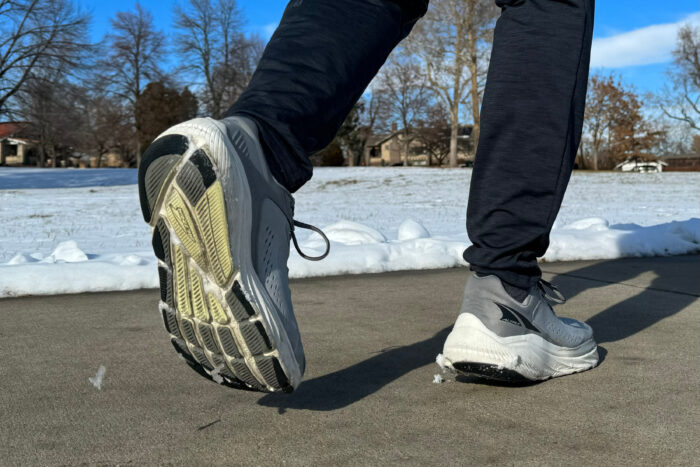# Zero-Drop, Max-Cushion: Altra Via Olympus 2 Review
Thanks to the Via Olympus 2, I have been running more miles in a zero-drop shoe in the latter half of this year than ever before.
After taking some time off from running, I became more open to zero-drop shoes as it would be less of an adjustment than transitioning from a full season of running in 4mm-drop shoes. These shoes are an enticing option for winter runs, especially for those focused on maintaining a baseline and shorter distances.
The Via Olympus is Altra’s road version of the Olympus, their max-cushion trail shoe, which is now in its fifth edition. It shares the same foot shape, 33mm stack height, and similar uppers as the trail version. However, the Via Olympus has a more pronounced rockered shape, a bouncier midsole, and replaces lugs with a new outsole featuring generous grooves for greater flexibility and reduced weight.
When tested, I found the initial run of the Olympus to be intriguing but a bit sloppy when pivoting and not as cushioned as it appeared.
The biggest change with the Via Olympus 2 is the increased cushioning, particularly under the forefoot. Like other Altra shoes, my toes feel a type of grip ahead of a more cushioned footbed. The cushioning under the heel is forgiving without being squishy and is probably still firmer compared to other max cushion shoes available.
In summary: Altra has softened the midsole cushioning on the Via Olympus 2 to better align with what runners expect from its most substantial road shoe. For fans of zero-drop shoes, the higher stack and rockered shape make the Via Olympus 2 a top contender for long-distance road running.
What’s New?

My criticisms of the debut Via Olympus were that it provided an overly firm ride for what I expected from a max cushioned shoe and I found some looseness in the fit when pivoting.
That has changed in the Via Olympus, which is why I’m writing this review. The EGO Max midsole is still not the softest, but the updated shoe now offers a softer landing with good energy return, assisted by the rocker shape.
Via Olympus Running Performance
Comfort and Fit
The Via Olympus 2 and the cushioning felt broken-in soft right out of the box. The shoe appears higher than it fits, a common trait in other max-cushioned shoes. The high-sided soles contribute to the overall stability of the design.
The heel collar provides enough rigidity for support, and I experienced no rubbing or stiffness there. Issues with my feet sliding around while pivoting and turning seem to have been resolved in this latest version of the Olympus.
I’ll also mention that the tongue stayed in place and the shoelaces remained tied, even when I didn’t double-knot them.

Ride and Durability
Altra may market this as its highest stack of cushioning, but I hesitate to label it as “max cushion,” at least not in comparison to brands like HOKA. There’s a substantial midsole underneath, but it’s not the most cushioned. The cushioning under the toebox, where my feet strike most often, felt softer than under the heel, which makes sense to me. Both areas felt softer than the prior model.
The firmer-than-expected midsole provides ample rebound, making the Via Olympus 2 peppy enough for running drills like pick-ups, at least for runners who train in maximal shoes.
While these are road running shoes, my training runs take place on a mix of asphalt, sidewalk, packed dirt, and crushed gravel. The Via Olympus 2 performed well on all of those surfaces and even outperformed lugged trail shoes on patches of leftover snow and mud, providing more surface contact and acting as a stable option.










